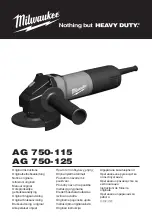
3.
Additional Safety Rules
Tool Use
DON’T FORCE TOOL
It will do the job better and safer at the rate for which
it was designed.
USE THE RIGHT TOOL
Don’t force a small tool or attachment to do the job of
a heavy duty tool. Don’t used tool for purpose not
intended—for example, don’t use a circular saw for
cutting tree limbs or logs.
SECURE WORK
Use clamps or a vise to hold work. It’s safer than
using your hand and it frees both hands to operate
the tool.
NEVER LEAVE TOOL RUNNING UNATTENDED
Turn power off. Don’t leave tool until it comes to a
complete stop.
Tool Care
DO NOT ALTER OR MISUSE TOOL
These tools are precision built. Any alteration or
modification not specified is misuse and may result in
dangerous conditions.
AVOID GASEOUS AREAS
Do not operate electric tools in a gaseous or
explosive atmosphere. Motors in these tools normally
spark, and may result in a dangerous condition.
MAINTAIN TOOLS WITH CARE
Keep tools sharp and clean for best and safest
performance. Follow instructions for lubricating and
changing accessories. Inspect tool cords periodically
and if damaged, have repaired by authorized service
facility. Inspect extension cords periodically and
replace if damaged. Keep handles dry, clean and
free from oil and grease.
Before connecting the tool to a power
source (receptacle, outlet, etc.), be sure
voltage supplied is the same as that specified on the
nameplate of the tool. A power source with a voltage
greater than that specified for the tool can result in
serious injury to the user, as well as damage to the
tool. If in doubt, DO NOT PLUG IN THE TOOL. Using
a power source with a voltage less than the nameplate
rating is harmful to the motor.
For your own safety, do not operate your
grinder until it is completely assembled
and installed according to the instructions … and until
you have read and understood the following:
1. Safety Rules . . . . . . . . . . . . . . . . . . . . . . . . . . . 2–4
2. Motor Specifications . . . . . . . . . . . . . . . . . . . . . . 5
3. Getting To Know Your Grinder . . . . . . . . . . . . . 8
4. Assembly and Adjustments . . . . . . . . . . . . 9–11
5. Operation . . . . . . . . . . . . . . . . . . . . . . . . . . . 12–13
7. Maintaining Your Grinder . . . . . . . . . . . . . . . . . 14
8. STABILITY OF THE BENCH GRINDER
If there is any tendency of the bench grinder to tilt or
move during any use, bolt it to the bench top or to a
piece of 3/4" exterior plywood large enough to stabilize
the grinder. Bolt the plywood to the underside of the
base so it extends beyond the sides of the base. DO
NOT USE PRESSED WOODS PANELS. They can
break unexpectedly. If the workpiece is too large to
easily support with one hand, provide an auxiliary
support.
Risk of injury due to accidental
starting. Do not use in an area where
children may be present.
9. LOCATION
Use the grinder in a well lit area and on a level surface,
clean and smooth enough to reduce the risk of trips and
falls. Use it where neither the operator nor the casual
observer is forced to stand in line with a potential
kickback.
10. PROTECTION: Eyes, hands, ears and body.
TO AVOID BEING PULLED INTO
THE SPINNING TOOL—
DO NOT WEAR: Loose fitting gloves
Necktie
Loose clothing
Jewelry
DO: TIE BACK LONG HAIR
ROLL LONG SLEEVES ABOVE ELBOWS
a. If any part of your grinder is missing, malfunctioning,
has been damaged or broken … such as the motor
switch, or other operating control, a safety device or the
power cord … cease operating immediately until the
particular part is properly repaired or replaced.
b. If you are not completely familiar with operating a
grinder, consult your instructor, supervisor or other
qualified individual.
WARNING
!
WARNING
!
WARNING
!
WARNING
!




































